by Jenny Rose | Feb 3, 2024 | Connection & Community, Emotional Intelligence
For me, February 1st is the first day of spring. I know it’s early. I like it that way. I like the anticipation, the half-intuited first stirring of life under the soil, under last year’s debris, the slow, cold wakening of seeds, stiff in their dormant shells but quickening, murmuring, “Is now the time …?”
The birds are the first harbingers for me. Here, in this place, a small city in central Maine, it’s the crows, the jays, the cardinals, and the little tufted titmice. The crows and jays complain in harsh voices of salt-encrusted pavement, tired snow over lumpy ice, the steely cold. Cardinal pairs flit in my bare, bedraggled forsythia, and visit the feeders, a startling splash of color in the grey and bone landscape.
The titmice sing. Joyful, bursting little songs of nests and eggs, of green growth and warming light. The first spears of bulbs, the budding lilac, the luscious magnolia petals are in their song, though those things are only memories and hopes in the February garden.
(As I edit this, the first goldfinch outside the window.)
(On the morning of the day I publish this, at dawn, the chickadee’s two-note spring call.)
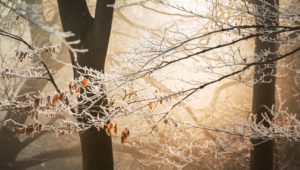
Photo by Ales Krivec on Unsplash
I have been feeling quiet. I’m burning down the last two Yule candles, gradually bringing out those of white and ivory, scented with lavender and herbs. Midwinter festivities are packed away, red table linen and warm-colored throws washed and folded for another season. I’ve been spring cleaning, making glass shine, mopping the scarred old floor, washing cupboards and doors. I walk to and from work bundled up in wool and fleece, the cleats on the bottoms of my boots clicking on the bare pavement and keeping me anchored in the ice and snow. The cold makes my eyes water, my nose run, and my ears hurt. At night, after closing the pools at 6:00, I drop a fluorescent sash around my backpack and chest and hold a small flashlight in the hand closest to the traffic, a white LED light shining ahead, a red flashing light showing from behind.
At times sleep has been thin and wrinkled this winter. In other periods of ebbing sleep I’ve felt frantic and exhausted, but this time I don’t mind. The long cold nights are restful whether I sleep or not, lying comfortable and warm in my chilly room, cocooned in linen sheets and a down comforter. I think of stars overhead, the moon on her path, ebbing and flowing, the tides lapping against the stony coast not so very far away. The hot water pipes in the radiators pop and click reassuringly.
I remember ice skating as a child, gliding smoothly over frost and snow, soaring over magically transformed water, cold biting like the crystalline sound of the sharp-edged skate blades, but warm in body from the rhythmic thrust of my legs. I haven’t skated in more than 50 years, but I remember it now, the freedom, the rhythm, the pleasure, the sense of inconsequence, as though nothing mattered, all was easy and graceful and flowing.
As the old year and winter inch over thresholds into something new, I am companioned by memories. This time last year is a constant whisper in my mind, because this time last year my mother was dying. I am not preoccupied with any time before that. After a lifetime of striving to understand and repair family history and relationships, I have surrendered to what was and what is now over. My battered empathy lies tranquil, not ravaged and torn but manageable, docile, turning over the pieces of last year with gentle intention.
In the clarity of cold winter, in my internal peace, I am alive, aware, receptive in new ways. I learned much in the last year, but intellectually. There was not time for more. The intensity of the situation, the constant crises, the long distance management, the anguish, the helplessness, the impossible tasks, the planning, demanded everything I had. I did not have time to process, to think long and deeply. I did not have the strength for it.
But now, now the past year echoes within my bones and flesh and memory. The ghosts of my feelings and experiences are miraculously without anguish, without horror, whispering a half-remembered story from childhood in which everything works out in the end. 
Mom herself does not haunt me. She wouldn’t come back to me in any case, but even before that thought has formed I realize she wouldn’t come back to any person. If she is in a place we can call somewhere, she’s with her animals. No one who knew her well or loved her could doubt it. She wouldn’t come back to anyone, not just me. I knew it before, but now I feel it, and the feeling is gliding, no friction, just freedom and clean, cold air. I can picture her face, laughing, joyful, with manes and tails, paws and shining coats, flopping tongues and pricked ears all around her. And I’m happy for her happiness.
A year ago I was home again after my first trip back to Colorado. I wrote on the ice, on the surface of things. I think without that I might not have stayed the course. It was my lifeline. I was surviving.
A year ago I noticed but did not feel the presence of the birds. The first weeks of Spring came and went; I was focused on the next trip to Colorado, on arranging an estate auction, on supporting my brother in finding renters for Mom’s home, on maintaining communication with Mom’s community, her caregivers, and family. I had no attention for anything but calls and texts as her condition and behavior worsened.
I was not here in April when the magnolia tree began to bloom. I did not kneel in the cold mud of the garden, rejoicing in the chilly sun as the bulbs first thrust up through the softening soil. We were dismantling Mom’s life in Colorado, reading the intimate stories of her history, her loneliness, her fear, and her private struggles. Revealing and releasing stories she never meant anyone to know, casting her life’s possessions and debris into the world, one way or another.
My brother was heroic. The community was stalwart. One step at a time, one item at a time, one mile and minute at a time, we got through it. Somehow.
Home again in May, and back to my life, but only in the motions. Some intuition kept my focus narrow, looking only at the next task, the next step. I gave myself time in the garden, time in the sun. I moved my body. I ate, and worked, and showered, and wrote, releasing my razor-sharp feelings and experience gingerly in words, like so many chips of ice. Now and then I found a moment of peace, a small oasis in between calls and texts, in between Mom’s querulous voice and caregiver check-ins, in between broken nights. But I did not try to plumb the depths of myself. I knew it was not time and I hadn’t the strength to stay safe.

Photo by Christopher Campbell on Unsplash
Summer bloomed fiercely and slowly withered as Mom did, until she was released in August.
She was released, but the work of wrapping up a life went on and on, the majority falling on my brother’s shoulders. He soldiered on. We signed and notarized papers, transferred ownership, sold the house, thought about taxes. I dealt with family jewelry and wrote an obituary, and chose a picture for the local paper.
Autumn came. On Halloween, I thought a year ago today she fell and broke her hip and it all began to end …
Winter came, and passed.
Spring is on the threshold. It feels like my first spring in this new house of ours. And now the ice begins to melt. Now I am not skating on the surface of things because the surface softens and melts, warms into depth and movement, into living water, cleansing and healing. The broken edges, the shards, blunted in the sun before melting away.
Water has ever been my strength and my safety. I take off my skates and float in my depths, my memories weightless, my ghosts drifting quietly, the echoes of the past fading away into peace as I allow them to brush against me, perhaps not for the last time – who knows? I will not be afraid if they visit me again. They are familiar now, and will melt again, as winter melts into spring.
“Ice holds memories … great islands of ice … hold many stories, but they’re just the fragments. Most of the stories are gone.”
—James Roberts at Into the Deep Woods
Questions:
- What signals spring to you?
- What intense experiences have you had to unpack slowly, over a long period of time?
- How do you manage your intense feelings?
Leave a comment below!
To read my fiction, serially published free every week, go here: 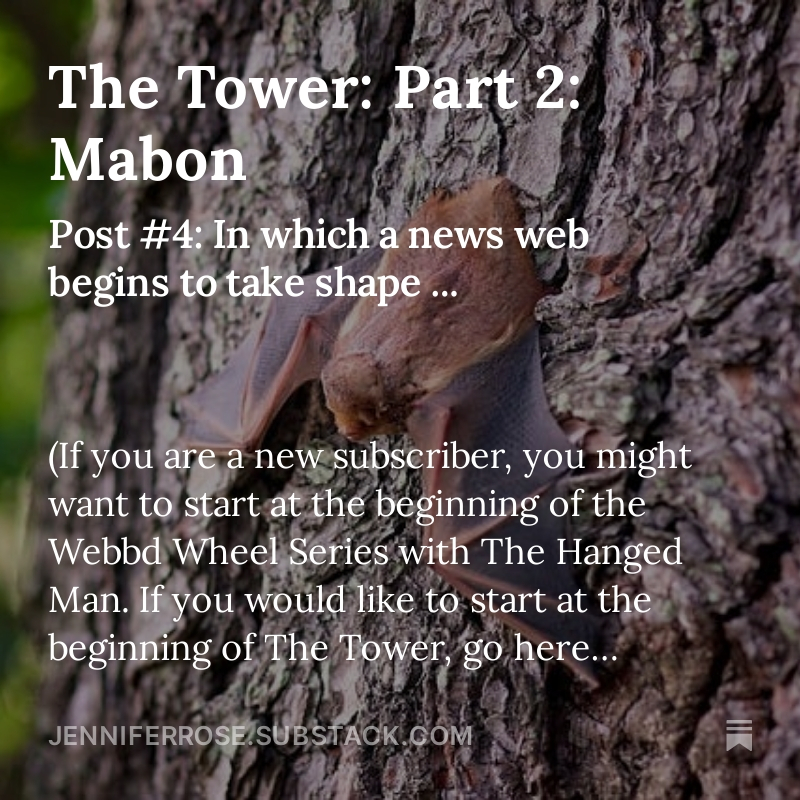
by Jenny Rose | Apr 8, 2023 | A Flourishing Woman, The Journey
Delayed closure is a wound treatment strategy in which complex wounds with extensive soft tissue damage and high levels of possible contaminants are treated with initial control of bleeding, cleaning, and debridement, and then left open for a period of time during which the possibility of infection is treated proactively. At the time of delayed wound closure, further debridement of scar tissue or dead tissue takes place.
As I count down the days and prepare for my second trip out to Colorado this year to manage my mother’s recent admission to memory and hospice care, the phrase ‘delayed closure’ reverberates through my mind.

Photo by Ryan Moreno on Unsplash
Delayed closure.
I have recognized for some weeks the significance of this second return to the place I called home for more than 20 years and my frail, confused, aging mother. At least, I have begun to recognize the significance. Every day brings added clarity. Awe is not too strong a word for what I feel.
When we flee people, places, or situations (and my flight from Colorado to Maine eight years ago was all three), it’s not an elegant, dignified process. It’s a frantic life-or-death flailing and thrashing, a single-minded determination to survive, whatever it takes.
The process leaves wreckage behind, a lot of unfinished business, a lot of rending and tearing, misunderstanding and hurt. It leaves, in other words, a complex psychic wound, not a clean laceration.
When I found myself in Maine, I thought I would not survive the trauma. I had torn myself up by the roots and gone to ground in a strange place I’d never been before. I felt like skin and hair wrapped around a suppurating wound of such longstanding duration and composed of so many different kinds of damage it didn’t seem possible it would ever heal. I didn’t think of healing. I didn’t hope for healing. I was a feral creature in survival mode.
I had no idea I had in fact saved my own life and taken the first steps to transformation, and I wouldn’t have cared if I’d known.
All I was doing was surviving.
In medical care, part of the strategy of delayed wound closure is giving the body’s natural defenses a chance to overcome infectious bacteria rather than sealing them in.
What were my natural defenses?
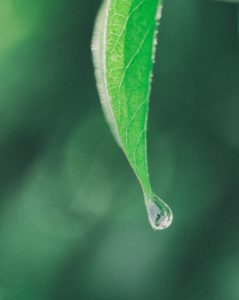
Photo by Aaron Burden on Unsplash
Water. My home in Colorado had been enduring a years-long drought. The wind blew all the time. Gaunt, dusty cattle stood sunken-eyed on plots of hard-baked ground. The wind blew relentlessly, scouring the land with flying sand, dust, and debris. We prayed for rain as we hauled grey water to our gardens. The city imposed restrictions on outside watering, car washing, any outside fires. Trees died. Fires consumed the land. It was apocalyptic, a hellscape with no relief in sight. Our water bills went up and up for simple household use. The rain didn’t come, year after year.
Maine was a revelation. Water. Big water, like I’d never seen before. The Kennebec River. Puddles everywhere, each with a duck. The people here call an enormous lake (to my eyes) a pond. Huge trees. Hip-high ferns. Moss.
Moss!
Rain. It rained. It actually rained. Measurable rain falling for hours, sweet, cool, life-giving. Mist. Fog. To breathe was to absorb water like a desiccated sponge. My cracked skin healed, drinking in the moisture. I lived in a house with a hand-dug well. No water bill. Free water! I trained myself to flush the toilet every time! My hair curled, growing out rather than down.
I lived in the country in Maine. No one knew me. No one knew I existed or any member of my family. For the first time in my life I escaped everyone’s expectations. No one demanded anything from me. No one watched me with critical eyes. No one told stories about me. I had no reputation. I was free, untethered from everyone and everything. I could think my thoughts and feel my feelings in safety and privacy. I could read, or work, or sleep, or take a walk, or garden without interruption or someone telling me I was failing. No one demanded anything from me. I had no emotional labor to do. I rested in the healing solitude of nature, laying my hands on trees, sitting on rocks watching little spring streams trickle, sitting in the sun listening to the birds, lying in bed listening to the owls, coyotes, and spring peepers in the pond.
Writing. In 2016, a year after I arrived, I began this blog. I had no expectations. My sole intent was to write my truths in my own uncensored voice without trying to please anyone, in spite of my fear. I had done some writing in Colorado, but always with a sense of guilt and shame, always with the fear of what others would think. I knew everything I wanted to write would be looked upon as unforgiveable betrayal or wildly shameful.
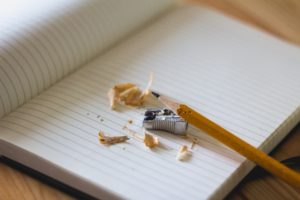
Photo by Angelina Litvin on Unsplash
In Maine, so far away in a new life, I discovered my courage and started, week by week, recording my journey from a broken, cringing creature, filled with self-loathing, to a strong, confident woman. At the same time, I pulled together my scrawled notes and the stories I’d written in the dim, hidden edges of my life and finished a book. Then I started another one. Then I finished the second book and started a third one.
These were my natural defenses: water, nature, and writing. Slowly they overcame the infection in my ravaged soul.
Yet the wound did not close. It stopped stinking and bleeding. Scar tissue formed. But I had lost too much to pull the edges together and make a neat closure. I had saved my life. I had survived and gone on to thrive. But I knew I was not done.
I know an old story about amends; it says only the hand that dealt the wound can heal it. Sometimes we must flee in order to live to fight another day. I fled, and I was right to do so, but flight leaves no time for closure. For closure sometimes we must go back.
Delayed closure.
The first time, in January, I was afraid to return. Afraid of judgement. Afraid of old pain. Afraid of what others would think, or say. I was afraid to have my memories stirred up. I was afraid my wound would tear open again, and this time I would not survive.
What happened instead was acceptance and love in the arms of old friends. My love for them was met by their love for me. The place, dear and familiar, welcomed me, though I no longer call it home. I found changes, of course, but not painful changes. Natural changes. I realized my fear had kept me from the closure I need, and my fear, once faced, amounted to nothing. In reclaiming my power, I was able to gain perspective. I’m just a part of that little town in the way it’s a part of me. I’m not the most important part of it and never was. It’s not the most important part of me and never was.
Having reclaimed my power, I felt and expressed my honest love and affection for the place and the people without needing anything in return, although I received much in return with gratitude and, I hope, grace. I examined the wound again, debriding scar tissue, cutting away necrosis, until my soul was healthy and vital once more. Some lines. A few silver scars. But free of infection, free of pain.
Still, when I came home to Maine again, I knew I was still not finished. Closure was not complete. I knew one day I would return once more to the place I had left.
In less than a week I’ll be there again, this time for a longer period. We must prepare for and hold a living estate sale: clean, sort, sell, discard, donate, and perhaps store a house full of, not my mother’s life, but her stuff. The things from which she constructed her identity. We must see to repairs and the business of welcoming renters in.
We will also visit my mother in memory care. If she’s well enough, we’ll take her out for a meal or a little gentle shopping. Perhaps we can sit in the sun with her. Or, perhaps she’ll be angry and bitter, refuse to sit in her wheelchair, demand to go buy a car, or some other wildly inappropriate and impossible thing.
I will see her again, though, speak to her, tell her I love her. I’ll check to be sure she has everything she needs. I’ll speak to the staff, to her hospice team. I’ll buy some books for her from the Friends of the Library bookstore she herself created and helped run for years. If she can’t go out, we’ll bring food in, perhaps a flower in a vase, and sit in the dining room where other residents can see her with her family, give her the dignity of being loved and cared for rather than forgotten and discarded.
It will be hard, or it will be easy, or it will be both. Dementia is like that. However it is, though, I won’t take anything to heart. Her power to hurt me has unraveled, along with her memory and cognition. She’s physically safe at last. Her physical and emotional wellbeing are no longer my responsibility. They never were, of course, but I didn’t believe that until recently.

Photo by Jeremy Bishop on Unsplash
I’m free. Free of my painful memories, free of old stories and narratives, free of the fear of what people will think of me. Free of fear, most of all. Freedom fills in that old wound and now, at last, I can pull the edges together, stitch them with words, with love, with wisdom, with forgiveness of her and myself. I have traveled a long, long road through darkness, despair, self-hatred, and trauma, but I still love. I still care. I still dance, and laugh, and write, and thrive. I still belong to Life.
I did the very best I could every step of that journey. I was blessed with guidance and friends and teachers. My wounds were not mortal.
Now, journey’s end. Delayed closure. New beginnings.
Questions:
- What is your experience of going to a place you called home after a long absence?
- What open wounds do you still have?
- How have you closed longstanding wounds?
- Do you see a living estate sale as a cruel betrayal or an appropriate business choice?
Leave a comment below!
To read my fiction, serially published free every week, go here: 
by Jenny Rose | Apr 5, 2018 | A Flourishing Woman, Body, Food
I posted three times about diet and food in 2017. You can find them here, here and here. They are among my most-read posts, and I’ve had enough comments and reads to encourage me to update my experience a year later. I still read everything I see regarding food, nutrition and diet, and I’m still learning what choices give me optimal health and following new science and data.

Photo by freddie marriage on Unsplash
For the record, I’m 54 years old, officially in menopause now, 5 feet 8 inches tall and a steady 140 lbs. I do a minimum of two hours of sweat-producing Tai Chi a week, swim laps for 45-60 minutes without stopping weekly, and walk energetically up and down a steep hill with my partner (about 50 minutes) five days a week. This walk is also sweat-producing. I dance occasionally and take shorter walks and snowshoe excursions several times a week. I go up and down steep flights of stairs all day long, shovel snow and help hump hardwood (heavy!) firewood into the barn. My blood pressure and pulse are both low, and my BMI is exactly where it’s supposed to be. I see a dentist and eye doctor regularly and a medical doctor rarely. I take no prescription medications and I don’t drink or smoke. I sleep 8-9 hours a night.
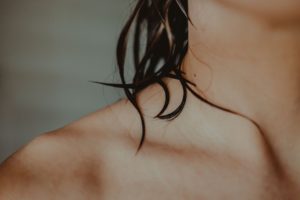
Photo by Tanja Heffner on Unsplash
In the summer of 2016, as I was slowly eating fewer and fewer plants and more and more meat and animal fats, I had trouble with hair loss. It occurred about six months into my transition to a very low-carb, high-fat diet. As you can imagine, it gave me pause. My hair is one of my few vanities (it misbehaves so gloriously!) and the women in my family have thick, healthy hair. I freaked out.
My first thought was thyroid. I was previously diagnosed as hypothyroid, but I had quit taking my medication when I moved to Maine in 2015 and had no further symptoms. I went to a doctor and had blood drawn. My thyroid levels were normal. Good news, but it didn’t explain my hair loss. At that particular time I was under a great deal of family stress, and the doctor assured me my hair loss was a stress reaction combined with menopause. I wasn’t much comforted, but I couldn’t find another explanation and he was undisturbed, so I decided to give it some time and see what happened.
The stress in my personal life resolved and after three or four weeks so did the hair loss. I didn’t think any more about it until recently, when my partner, who also eats low-carb, high-fat, told me he’d come across a blog post about temporary hair loss being a side effect of transitioning to a ketogenic diet, and it generally occurs around six months into the diet. Hair loss explained. It’s worth noting that since then, my hair is thicker, wilder and curlier than ever, and it grows fast. I need a cut at least every five weeks.

Photo by Amy Reed on Unsplash
In my old life, when I was eating a mostly plant-based diet, I really struggled with constipation. I took fiber supplements and ate loads of fiber-rich foods every day, but it seemed like the more fiber I took, the more trouble I had. I also had a lot of bloating and water retention, which was discouraging. I felt fat, and at the same time I felt depleted.
One of my biggest concerns about trying a low-carb diet was the issue of fiber. Everything I’d ever read told me unequivocally that it’s necessary to eat fiber to maintain a healthy GI tract, and cutting out plant-based food seemed to be going in the opposite direction.
What I discovered was that I still struggled with constipation, but it didn’t get worse. I was surprised, but I still wanted to fix the problem. I did a lot of reading on blogs about eating low or zero carb, and found constipation was a concern for many people. Everything I read pointed to focusing on micronutrients, especially when transitioning to low-carb, high-fat eating. I read a lot about electrolytes: salt, magnesium, calcium and potassium. My plant-based diet was low-salt (I was careful about salt and rarely added it when cooking and baking) and high in magnesium and potassium. My understanding was that salt is very bad for us, and causes high blood pressure, water retention and a myriad of other problems. Further reading informed me salt is a necessary nutrient, and I realized I was getting well below the recommended levels of salt, potassium and magnesium in my diet of meat and fat.

Photo by Jason Tuinstra on Unsplash
I began to supplement magnesium and potassium, and I stopped restricting salt (which I’ve always loved). I also began making sure I drink at least 3 liters of water a day, more when it’s hot and humid. The other thing I read about consistently, and this was the hardest for me, was that one needs to eat at least a pound of meat a day, and many people aim for two. That’s a lot of meat!
When I implemented all this, my constipation went away. My blood pressure and water retention did not increase with increased salt. I never have bloating. If I have trouble now, it’s because I’ve been too sedentary, not drinking or eating enough, or I forgot my usual supplements.
When I began eating low-carb, high-fat, I also started having severe leg and foot cramps, which I’d never had before. They weren’t like my chronic pain and spasm, but in the middle of the night, without warning, my calf or foot would cramp, waking me in a hurry and making me writhe for a few seconds before it relaxed. I was concerned this was a sign that eating this way was as insane and unhealthy as most people say it is and I was starving my body of what it needed, but this, too, turned out to be a function of imbalanced electrolytes and under hydration. I haven’t had any kind of cramp since last year.
In retrospect, I wonder if both my chronic pain and spasm and my constipation had a lot to do with imbalanced electrolytes all along. It may be I’ve been chronically sodium deficient. I also believe I’ve been chronically under hydrated for most of my life. I have to really pay attention in order to get three plus liters of water a day, and I lived in Colorado, which is terribly dry, before I came to Maine. Obviously, staying well hydrated is essential to healthy bowel habits.
Another problem I had was debilitating migraine headaches that lasted for at least 24 hours and made it impossible to function. Photophobia, phonophobia, neuralgia and pounding pain had me in a dark room with an ice pack. For two or three years I had them once a month, right at the full moon. As I started eating meat and fat and reducing carbs, they gradually diminished in intensity, frequency and length. I’ve had one so far this year, and I was able to function all the way through it, albeit with discomfort.
So what, exactly, does my current diet look like?
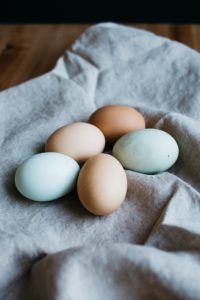
Photo by Rachael Gorjestani on Unsplash
I eat three thick slices of bacon and two sausage links with four to five buttered eggs every morning. It’s always delicious and I’m not even close to bored eating it daily. I also drink my first liter of water in unsweetened green tea and just plain water with breakfast. Every other day I put a spoonful of fresh farm cream cheese with garlic and herbs on the eggs. We usually eat before 8:00 a.m.
I don’t think about food again until around 3:00 p.m. I write for three or four hours, exercise, do housework, run errands, etc. I usually drink a couple more cups of herbal tea and I drink at least another liter of water. Sometime mid afternoon I’ll feel hungry. My partner makes a beef stew to die for, but we don’t always have that. We always have ground beef, however, and last fall we saved money and bought half a locally-raised cow, butchered and packaged to our specifications. The meat is grass-fed and very lean. I’m sure this is what most people want, but we find it too lean. Because of that, I make a burger patty or crumble and cook the beef in the frying pan from breakfast in order to take advantage of the bacon and sausage fat. The lean ground beef soaks up the fat pretty well, especially if I just crumble and cook it, which takes about 2 minutes. I aim to cook at least 3/4 of a pound of burger.
I find this extremely filling and satisfying. I drink a lot of water with it. Now and then I spoon garlic and herb farm cheese on top. If I’m really starving or feel extra depleted, I bake a half a sweet potato or white potato, anoint it with lots of butter and fresh farm sour cream. I don’t eat any kind of carb without eating fat and meat first.
I also buy unsweetened, full-fat farm yoghurt, and sometimes after my afternoon meal I’ll eat a couple big spoonfuls of that. When there is beef stew, I occasionally like to have a half a thin slice of locally baked wheat bread, liberally buttered, with the gravy. I love ice cream, and about once a week I eat a small bowl of hard ice cream, but only after a good meal of meat and fat. If we buy ice cream in town, I get a child’s serving in a bowl. Cones are just empty carbs, and they make me hurt. My partner likes banana bread, and he occasionally bakes a very low-sugar version. Sometimes I’ll eat a half a thin slice, thickly buttered, as a treat after my afternoon meal.
I have a tendency to react badly to nuts, but I love peanut butter, and we buy nothing-added-but-salt peanut butter from East Wind in bulk. Once a week I eat a spoonful of that on a small square of buttered bread.
Oddly, I’ve discovered eating one spoonful of ice cream a day causes far more problems than having a small serving once a week. For me, there seems to be a cumulative effect in terms of carbs. Now and then I splurge on a carb, just for fun, and if I’ve eaten meat and fat first I can get away with it without too many consequences. If I squirt a little catsup on my burger three days in a row, though, I’m going to start to have pain that limits my activity level and sleep. Commercial catsup, for some stupid reason, is sweetened.
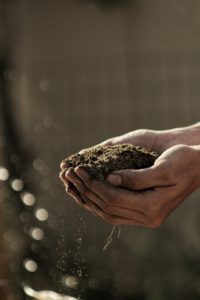
Photo by Gabriel Jimenez on Unsplash
Since I last wrote about food, I’ve done a lot of reading on permaculture, holistic food production, and land management. Please see my Resource page for links. What I’ve learned is that monocropping is biocide. Large-scale animal production can be equally catastrophic for the land and environment. What we know now is that a healthy complex system (i.e., Planet Earth, left undisturbed) contains an essential mix of plants, fungi, microorganisms, insects and animals. Earth is evolved for such communities, and we will destroy the planet if we don’t figure out how to emulate, nurture, protect and participate in such systems. All life will starve to death.
The most extraordinary thing about eating this way, and the hardest part to communicate to someone who doesn’t, is the level of hunger satisfaction. Previously, I was always snacking. A piece of fruit, a couple of pieces of toast, a salad, a smoothie. I was always hungry, and I was always ashamed of it. My shame caused me to withhold food from myself, which only made my cravings worse. My weight, mood and energy fluctuated wildly. My sleep was bad. I had constant pain. I was always thinking about food, one way or another.
It’s hard to express how different it is to eat a big breakfast and walk away feeling really satisfied and full until six or seven hours later. No craving. No shame. No snacking. No sense of deprivation. No counting calories or weighing portions. Then, another big meal, the evening routine and bedtime, satisfied and satiated. When I’m hungry, I eat. I don’t care what time it is or what else is going on. When I’m full, I stop eating. That’s it.
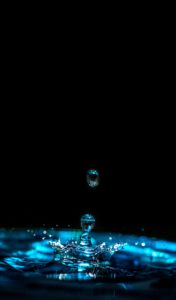
Photo by Erda Estremera on Unsplash
The same level of satisfaction applies to drinking water. We drink filtered water from our old hand-dug well, and I never thought just plain water could give me so much pleasure. You couldn’t pay me to drink soda or sweet tea or any of the things I used to drink. When I’m thirsty, I want water, lovely, fresh, cool, clean water. I’m never bored with it. I never want anything else. It satisfies me in a way that’s so deep it’s almost sensual.
I never feel deprived.
It’s worth noting that the absolutely most satisfying meat is beef. I eat some chicken and, occasionally, turkey, but I have to eat two or three times as much in order to get the same level of satiation, and those meats are less fatty than beef. Pork is good because it’s high-fat, and we hope to be able to buy a half a pig in the future from local farmers.
Sometimes, if I’ve been working unusually hard physically or am unusually emotionally upset, I’ll need a fast snack. In this case, hard-boiled eggs are portable, quick and healthy. Every couple of months I buy a plain ham, unsweetened, smoked, or otherwise manipulated, as fatty as I can find. I thin slice it and pack it into small baggies, which I throw in the freezer until wanted. This provides a quick, high-fat, high-salt, tasty snack I can eat on the run or in a hurry. If I’m going to visit a friend and have a cup of tea or a chat, I eat a little ham so I can have a cracker or cookie with my friend without paying for it in pain.
We have the great good fortune to be able to buy food from a farm. I no longer buy commercial milk, cheese, yoghurt, sour cream or eggs. Nothing compares to food that hasn’t left the farm until you take it home. It puts money back into the local community, fosters small-scale farmers who are working holistically with animals and plants (and they work day and night, let me assure you), and it allows me to know exactly where my food is coming from and how it’s being handled. It’s also fresh and far more delicious than anything available in the grocery store.
I’ve seen blogs and posts from people who claim to have tried a low or zero-carb, high-fat diet and say it “doesn’t work.” I’m not sure what “doesn’t work” means, exactly, but I always long to ask a lot of nosey questions. First, what was the goal? Why did they try it? Secondly, how long did they stick to it? Thirdly, did they really commit to it? Did they suspend their soda habit, stop sweetening their coffee and ditch the “healthy” granola bars? Did they eat meat and animal fat and drink water and nothing else? Lastly, do they smoke tobacco or drink? All alcohol is carbs. Do they take any prescription drugs or use recreational drugs?
Another thing I’ve heard is that eating this way is unmanageable socially. I don’t buy that. If you’re trying to change the way you eat in order to feel better and improve your health and your buddies at the bar give you a bad time for refusing nachos and cheese fries, grow a pair and tell them to back off! Better yet, get them to join you! Do a two-week challenge and bet on who will lose the most weight. True friends will support friends in maintaining health. If you can pack a sandwich for lunch, you can pack fatty ham, hard boiled eggs, and a container of full-fat unsweetened yoghurt. If your only option is fast food, buy a couple of burgers and ditch the buns and condiments. If you want to eat this way, you can. Nobody cares. Nobody’s really paying attention. They’re too busy with their own food preoccupations! Pot luck? Take a tray of cold cuts or deviled eggs. We go out to eat a couple of times a week and enjoy eggs and sausage, meatloaf, pot roast and chopped sirloin. Hold the bread, hold the side salad!
Eating in this way has transformed my life and my health. Shopping is easy, infrequent and fast. Every ten days or so I visit my friend’s farm, buy eight dozen eggs, cheese, sour cream and/or yoghurt (according to need), chat and exchange a hug. I spend a half hour in the kitchen making breakfast, doing dishes, giving the cat fresh water, looking out the windows, watching the birds and thinking about the day ahead. My afternoon meal is either already made (stew) or takes two or three minutes to cook in the breakfast frying pain. I don’t meal plan. We know exactly what we need to budget to eat well. I don’t need a lot of gear and gadgets or cupboard space. The refrigerator is not overflowing with who-knows-what leftovers and outdated food. Our collection of plastic Tupperware containers is virtually unused (which is good, because there are mice in that particular cupboard!). We don’t produce much trash, because we don’t buy cans, bags and boxes. We recycle all our egg cartons, plastic and aluminum. We compost egg shells, tea bags, coffee grounds, and any small amount of vegetable matter. Meat and bacon grease is also perfectly suitable for compost, managed properly. We know farmers who have buried a whole dead goat in the center of their compost pile with no smell and no problem.
I don’t diet. I eat food — joyously, effortlessly, with great satisfaction and pleasure. I drink water with a deep sense of gratitude that I have clean water to drink. I feel healthy, happy, energetic and filled with vitality. My body is my friend and ally, and I think it’s miraculously lovely.
Diet is a personal choice. I suspect different bodies have different requirements. Some people can’t eat eggs or dairy. Some are particularly sensitive to the herbicides in our grains. I also suspect that a lot of the current mainstream information and advice about food is skewed and misleading. I encourage everyone to research for themselves. A sampling of the links I’ve provided in these posts and on my Resource page may provide you with new information and data. Ultimately, the choice is yours, and yours alone. If you’re happy with your physical and mental health, your relationship to food and your body, and you have no need to take over-the-counter or prescription medication, you obviously have figured out what works for you. If not, it’s important to understand you’re not alone and not everyone (not even all doctors) is in agreement about diet.
As for me, I will never go back to a plant-based diet, chronic pain and spasm, constipation, migraines, hypothyroidism, anxiety and depression, insomnia and weight problems. I’m a carnivore, and I eat meat and animal fat with great relish.
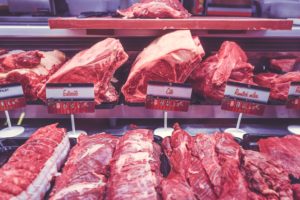
Photo by Lukas Budimaier on Unsplash
All content on this site ©2018
Jennifer Rose
except where otherwise noted
by Jenny Rose | Jul 13, 2017 | A Flourishing Woman, Spirit
I first began thinking about bones 25 years ago when I was given a copy of Clarissa PInkola Estes’s book, Women Who Run With the Wolves. She writes about discovering stories of bone people in the Southwest. Bone people are old ones who collect bones in a desert between the worlds and bring dead animals and humans back to life.
Reanimation is a common creative and spiritual theme. Bones are like seeds; they are the remnants of life, and thus the base material from which to build new life. Bones are the simple starting point, the hidden scaffold and substance that survives.
Several times in my life I’ve found myself walking in a trackless emotional desert, alone, lost, frightened and injured. Old stories tell us during these times we must seek and gather our discarded, stolen and lost bones in order to call ourselves home.
Bones can be hard to see under layers of clothing, flesh, distraction and scar tissue. Perhaps that’s why it was the desert dwellers who kept bone people stories alive. The desert is clean and uncluttered, and the vast sky and sweep of land hold space for stillness and inward journeying.
Bone collecting is like treasure hunting. The first time I went bone collecting, I traveled backwards and excavated memories of my child self. I compared those memories to my adult life and began to sift for my bones, those indestructible pieces of self that have always been present, come what may, sustaining and shaping me from the beginning.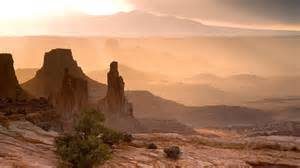
I discovered I’d thrown a lot of bones away over the years. Some I rejected because I judged them as ugly or misshapen. I refused to claim them. Others I grieved to discard, but I believed they were useless, unworthy and/or unlovable, so I dropped them and walked on without marking the spot where they lay.
The desert between the worlds has become a home to me now. The sands know the scent of the naked sole of my foot and the soaring vultures recognize my figure as I wander below them, insignificant as an ant. I’ve crawled and searched, remembered and listened for my whispered name when my missing bones feel me draw near. Some are broken and stained, incomplete fragments that no longer tell their entire story about me, but I’ve learned patience and persistence, and I save every shard and splinter. I’ve traveled miles in the desert to reclaim all those bones, groping my way through old memories, feelings and bits of conversation, sifting my bones from the garbage dump of words that did not belong to me, expectations, rules, beliefs and storm debris from storms that swept me up, though they were not mine.
Over and over, I’ve felt I’ve come to the end of everything, only to find a whole new horizon just a few steps away, at the top of a hill I didn’t know I was climbing. Each time that happens, I pause and inventory my bones. Bone collection has become an external practice as well as an internal one. I’m less and less interested in obscuring the essentials in my life with distraction, objects and complications.
This summer I have a new dimension of perception in discerning the bones of each day, each week and each season. Living simply as we do, having time to stretch out mentally, spiritually and creatively, I’m experiencing for the first time the joy of casting myself into a day with no list, no agenda, no expectations and lively curiosity.
This is, for me, a summer of wood. We’re clearing a knoll of land in order to build a cabin, thinning a grove of spindly alders and cutting an occasional small tree growing in the field which is our building site. As each tree falls, I haul it into the wall of forest surrounding the clearing. In the sunny field, the growth is waist-high, and as I drag trees through it, the sweet scent of milkweed mingles with the smell of fresh-cut wood. Wild cucumber catches at my feet, invisible in the thick growth, and I fall, and fall again, getting up hastily because, although my clothing is doused in bug repellent, rolling on the ground is a foolish exposure to ticks, not to mention rampant poison ivy.
In Maine in the summer, this kind of work is done in light-colored pants and long sleeves to protect from black flies, mosquitoes, poison ivy, nettles and the inevitable ticks. Five minutes of exertion leaves me sweating heavily under the necessary layer of clothing, breathless in the heavy, humid air.
Stepping from the field into the forest, the air cools and I’m shaded from the sun. Here, the undergrowth diminishes and mainly consists of huge ferns, but I still slip and fall, as the forest floor is littered with rotting tree debris and liberally scattered with moss-covered boulders and stones. I drag the cut trees in under the canopy so they can gradually rot and feed their living brethren and the rest of the forest system.
In the driveway, we are processing enormous piles of tree debris from trimming two live trees and from a fallen maple. The maples we trimmed provide us with welcome shade as we work. I fork wheelbarrow load after wheelbarrow load of twigs, small branches and dead leaves off the driveway and tip them over a steep hill out of sight below the house. My partner works with a chainsaw, and its snarl, along with the smell of cut wood, becomes one of this summer’s bones.
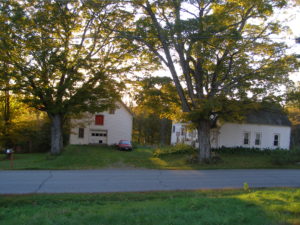
A generous neighbor loaned us his splitter, and once the maple (rock maple, which dulls chainsaws at an alarming rate) is cut into wood stove lengths, we heave the rounds onto the purring splitter, and the smell of the gas engine and sound of the relentless maul cleaving the wood becomes another of summer’s bones.
The healthy wood parts smoothly, revealing ivory, cream, and pinkish-red grain. The diseased wood breaks open, showing honeycombed defects, or crumbling, blackened rot that smells, oddly, like vomit. Heavy, thick bark peels from the wood like scabs as we work. Here in the driveway, I risk working in shorts with bare arms, but the wood is heavy and unwieldy and my legs and arms are bruised and scratched. The way I hold the rake invariably rubs a blister on my left thumb. We sweat through our clothes and I have to keep wiping my forehead and upper lip with my bare forearm and gloved wrist. Hard wood is heavy, especially when still wet, and the inside of my wrist is bruised from supporting two or three pieces as I carry firewood to the wheelbarrow, into the barn or into the cellar for stacking.
Some of this wood has been piled in the driveway for a year. As we work, we uncover an insultingly large woodchuck hole. We find a red salamander, about two inches long. My partner rescues a grass snake from a brush pile and relocates it away from the pitchfork tines. We accidentally lift away a shrew’s roof, and my partner catches the grey velvet covered creature in his gloved hand and releases it over the hill in a safe place. We brush away crickets, earwigs and worms. We split one huge round and little red ants swarm over it, hysterically collecting a broad swathe of exposed white eggs. My gloves are covered with them, and the ones who run fast crawl onto my arms and bite before I can brush them off. We set those pieces of wood aside before splitting them further to give the ants a chance to find a new nursery.
We have birdfeeders along the driveway, and the birds are the backbone of the summer days, stretching from dawn to dusk. As soon as we take a break from work, the woodpeckers gleefully swoop in for uncovered insect tidbits, and the nuthatches scurry up and down the trunks of the standing trees with their fluffy, uncoordinated offspring. The finches and sparrows return to the seed feeders from their observation posts high in the surrounding canopy.
Our resident chipmunk is so curious he can’t stay away, but as we disassemble all his best hidey holes he scolds endlessly, like a shrill and irritated metronome, glaring from under the hostas or the gap in the porch floor.

Nesting Phoebe
birdsandbloomsblog.com
Strangely, the shy phoebes like best to nest in the barn, in spite of my partner frequently playing music and our wood stacking and other noisy activities. They arrow in and out of several broken windows when the barn is shut, but on days when we’re working, they use the same door we do. Because of them, the cool barn is not only a haven of shade, but free of flies and mosquitoes. We know where the nest is, but we’re careful to ignore it and whichever motionless parent is sitting on the eggs when we happen to be present. Even the nestlings are still and silent as stone when we enter. The phoebes are currently raising their second brood, and their first set of offspring darts all over the place, hunting insects and filling the days with their distinctive cry, which gives them their name.
The bones of summer in this place mingle with my own bones. We are a bruise, a scratch, a sticky film of sweat on the skin, a sly mosquito bite. We are birds strung on the lace of trees; the private life of snake, shrew, salamander and woodchuck; the determined persistence of insects. We are tree and water and moss-covered stone. We are the smell of rotten wood, of sweat, of blossom. We are the breeze in the tree, the sound of the phoebe questing for insects, the tapping woodpecker, the hunting hawk’s cry as it circles, and the clamor of the tools we use to work on our land.
The days saunter through the season, leading me forward by the hand, and I follow, stopping every now and then to collect and record the ravishing experience we call life in words, and each word is a miniscule bone, too, each page a scatter of tiny bony seeds that wait for warmth and light, water and the soil of life and death in order to take root, grow, blossom, fruit and die, again … and again … and again.
All content on this site ©2017
Jennifer Rose
except where otherwise noted
by Jenny Rose | Jun 22, 2017 | A Flourishing Woman, Self-Love
Recently I went back to the little mountain town in the Southern Colorado Rockies I called home for twenty years, and wrapped up the sale of my house. It was an important trip for me, one which I’ve been anticipating ever since I arrived in Maine two and a half years ago. My partner and I drove out and drove back. I didn’t try to blog or write on the road, but I made a lot of notes and I discovered a persistent theme.
Reclamation, according to a quickie internet search, means “the process of claiming something back or of reasserting a right” or “the cultivation of waste land or land formerly under water.” It strikes me there’s an interesting and subtle possibility of conflict in those two definitions. What exactly is waste land, and who has the power to define it? Also, what does cultivation mean? Big Ag? Monocropping? Pesticides and Roundup? Or cultivation by plants, animals and wind?
In any event, I’ve been carrying the word reclamation for some years now like a talisman. It’s a cord linking events and choices of the last years of my life together.

Photo by Tanja Heffner on Unsplash
I remember exactly when it started. I was sitting in a chair in the salon where a friend cut my hair for years. In the mirror, I could see my hair falling over my shoulders and down my back, thick and wavy and beginning to be streaked with grey. I was desolate because of a broken relationship, and I saw a woman who was unwanted in that mirror. I didn’t want to be her anymore. I wanted to be someone else. My friend asked me what I wanted to do and I told her to cut it all off. “Reclamation,” I said. I couldn’t say more because I didn’t want to break into sobs, but she knew exactly what I meant, and she tied a smock around my neck and started cutting.
My ex-boyfriend had loved my hair. I loved it, too. It made me feel sexy and beautiful and feminine. Cutting it was the first step I took on the road leading me to this attic space in central Maine, where I sit this summer morning (with short hair) writing with the windows open and the sound of crickets, frogs and birds flowing in.
I held onto that word, reclamation. It became a boat to sail away in, and then a lifeboat, and then a raft and then a spar of wood in a fathomless sea of floating debris that kept me alive until current and waves took me back to shore.

Photo by Edewaa Foster on Unsplash
The little town I lived in had no claim to fame or big dollar tourism except for a golf course. When I moved there the course was renowned for being one of the most beautiful in the country, and visitors came from all over during the summer to play there, filling the inns and RV parks. Then drought struck that part of Colorado, the golf course was sold to an absentee owner who immediately got crosswise with the town, and gradually, due to a mixture of water problems, politics and general assholery on the part of the owner, the golf course went downhill, people lost jobs, the greens became unkempt and the tourists stopped coming. Then, just about the time I left town, the golf course closed.
I don’t play golf and my living fortunately didn’t depend on the tourist trade, but every morning, just before dawn, I walked on the golf course.
I didn’t do it for exercise or as a discipline. It was my lifeline. It was the one place where I never failed. I was guaranteed solitude and peace. Nobody knew where I was. I knew the course so well I could disappear into it, be absorbed. I had several routes, one for ordinary days, one for days of grief, one for days of rage and the longest one for days of despair. I used some of the cart paths, but mostly I followed the contours and edges of the greens and walked along the river, which was generally only a trickle, if not entirely dry. I often heard owls going to roost as meadowlarks began their morning chorus. I saw bears, foxes, skunks, deer and geese.
In the days of relative plenty, maintenance men worked as early as I was walking, but I was a familiar local figure and we ignored each other. I avoided them and they only saw me at a distance. There was an elaborate sprinkler system, of course, that worked all night every night and made the whole place fresh and green and cool, a stark contrast to my daily reality of hauling or pumping grey water out to my garden because of drought and watering restrictions. I lived a five-minute walk away.
During our recent trip we only spent one night in that little town, but I woke early, slid into my clothes and walked to the golf course. I knew it had been closed altogether for some time. This year the drought momentarily broke in the valley with record amounts of snow and rain, and the river that so often dried up flooded, both on the course and through the town. As I slipped through the gates and passed the “no trespassing” signs in the dark of early dawn, I could hear the river, an amazing, miraculous sound. The scent and chill kiss in the air of running water was very different from the mechanical chik, chik, chik of an automatic sprinkler.
The cart path was rutted, muddy and overgrown. Large tree limbs had fallen and nobody cleared them away. The river actually broke out of its banks and spread across a former green. I’d seen pictures in the local paper, but I still couldn’t believe my eyes. The town sent in machinery to make barriers out of heaped-up debris and mud. Whole trees had toppled, their root balls pathetically exposed to the sky.
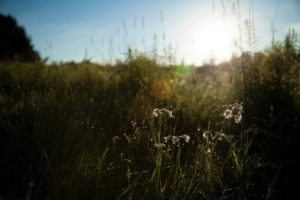
Photo by Alejandro Escamilla on Unsplash
Once, I could have walked several paths on the golf course blindfolded. I often was there in the dark. Now my footing was uncertain. The grass grew up to my waist and I kept tripping over hidden windfall branches. Weeds filled the sand traps. The greens were, of course, gone. The groomed contours that once marked my route had vanished, forcing me to slow down and move more cautiously. I strained my eyes to discover familiar slopes and hollows in the dim light.
As I moved deeper into the old course, I thought of all the hundreds of mornings I’ve spent there, praying, weeping, raging, pressing myself against nature in every mood and season. I took my joy there, my hope, my dreams, and my gratitude practice. The golf course was a place of creative inspiration, a place of guidance and comfort, a place in which to staunch wounds enough to carry on another day. I was real there. I didn’t try to hide from myself.
That highly-groomed, herbicide-gagged, shaved, enslaved, money-making piece of land (a waste land) is going wild again. It was captured, bought, and pimped by a businessman in order to create a profit. Now, Mother Nature reclaims her own. The land begins to remember itself. As I walked and the light increased, showing me myriad signs of healing, I felt akin to the land. What is happening there is happening to me. I had a pimp, too — myself. I sold myself for what I thought I was worth in order to get what I needed. Now the land and I reclaim ourselves from a bleak and limited culture that relies on chemicals, profit and power-over rather than natural cycles and cooperation.
Reclamation is not a controlled, civilized process. It’s wild, sometimes catastrophic. The river made a scar where it broke its banks and uprooted trees, but it carved out a new bed for itself. The old bed will fill in. New growth will cover all that exposed earth. The downed limbs and trees will rot and feed the soil and mycelium while native plants and grasses return. Is this what we mean by waste land? Forest fire, flood and storm are acts of nature that reshape the land and environment. Life dies and renews, one act leading to the other. We often experience reclamation as terrifying and tragic. Human beings, for the most part, don’t welcome change unless we control it.
Yet we do change. The world changes. The weather changes. Those around us change. We can neither stop nor control it in any significant way, and I’m entirely grateful for that. The golf course and I are messy. Our hair is disheveled. Our trim, neat lines are blurred. The high unmown grass through which I waded brushed against the hair on my bare legs. The water feeding the land and the water of feeling that feeds me have carved a new, wider path. Bridges and trees sag and unravel, not trash but compost for the next thing. Paths and fences fall into disrepair. Grass and saplings mingle freely, each reaching toward the other at the edges.
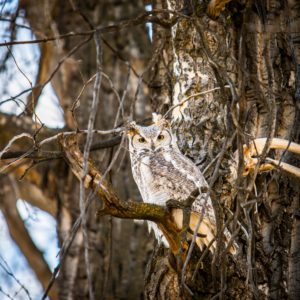
Photo by Laterjay Photography on Unsplash
Snakes, rabbits and insects live again in the shelter of the grasses. Does can leave their fawns safely concealed while they browse, and their presence will bring the mountain lions down from the foothills. Owls will find abundant mice, voles and other rodents in what was a carpet of sterile green velvet. The beaver and raccoons will no longer be trapped or shot, lest they disturb the regulated beauty of the water features or annoy the tourists. Over all this complex, creative system, the meadowlark still sings, that king of the high fields and plains, and his song still brings tears to my eyes and an ache to my throat.
That land will always be home to the woman I was. I was glad to return for a brief hour and realize my beloved place has moved on, just as I have. The land and I were both over-civilized into waste land, but now we’re reclaiming ourselves. The golf course and I reassert our right to be what we are. We surrender to change, to mess, and to the transformative edge of chaos.
All content on this site ©2017
Jennifer Rose
except where otherwise noted






















